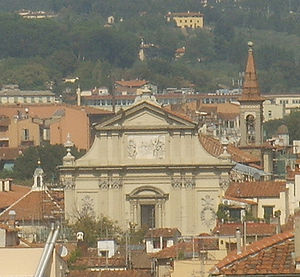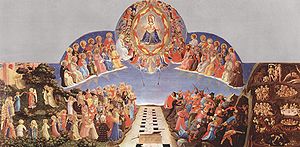
San Marco, Florence
Encyclopedia

Florence
Florence is the capital city of the Italian region of Tuscany and of the province of Florence. It is the most populous city in Tuscany, with approximately 370,000 inhabitants, expanding to over 1.5 million in the metropolitan area....
, Italy
Italy
Italy , officially the Italian Republic languages]] under the European Charter for Regional or Minority Languages. In each of these, Italy's official name is as follows:;;;;;;;;), is a unitary parliamentary republic in South-Central Europe. To the north it borders France, Switzerland, Austria and...
. It comprises a church and a convent
Convent
A convent is either a community of priests, religious brothers, religious sisters, or nuns, or the building used by the community, particularly in the Roman Catholic Church and in the Anglican Communion...
. The convent, which is now a museum
Museum
A museum is an institution that cares for a collection of artifacts and other objects of scientific, artistic, cultural, or historical importance and makes them available for public viewing through exhibits that may be permanent or temporary. Most large museums are located in major cities...
, has three claims to fame: during the 15th century it was home to two famous Dominicans
Dominican Order
The Order of Preachers , after the 15th century more commonly known as the Dominican Order or Dominicans, is a Catholic religious order founded by Saint Dominic and approved by Pope Honorius III on 22 December 1216 in France...
, the painter Fra Angelico
Fra Angelico
Fra Angelico , born Guido di Pietro, was an Early Italian Renaissance painter described by Vasari in his Lives of the Artists as having "a rare and perfect talent"...
and the preacher, Girolamo Savonarola
Girolamo Savonarola
Girolamo Savonarola was an Italian Dominican friar, Scholastic, and an influential contributor to the politics of Florence from 1494 until his execution in 1498. He was known for his book burning, destruction of what he considered immoral art, and what he thought the Renaissance—which began in his...
. Also housed at the convent is a famous collection of manuscripts in a library built by Michelozzo
Michelozzo
thumb|250px|[[Palazzo Medici]] in Florence.Michelozzo di Bartolomeo Michelozzi was an Italian architect and sculptor.-Biography:...
.
The present convent occupies the site where a Vallombrosan
Vallumbrosan Order
The Vallumbrosan Order is a Roman Catholic religious order, technically a Benedictine congregation, which derives its name from the motherhouse, Vallombrosa , situated c...
monastery existed in the 12th century, which later passed to Benedictine monks of the Silvestrine line. In 1435 the Benedictines were replaced by Dominicans from the Convent of San Domenico
Convent of San Domenico, Fiesole
The Convent of San Domenico is a Dominican convent in Fiesole, Italy, situated between the hill of Fiesole and the suburbs of Florence. It was founded in 1406 and completed in 1435 on the initiative of Giovanni Dominici and the bishop of Fiesole, Jacopo Altoviti, both of them monks at the Basilica...
in Fiesole
Fiesole
Fiesole is a town and comune of the province of Florence in the Italian region of Tuscany, on a famously scenic height above Florence, 8 km NE of that city...
. Two years later, they appealed to Cosimo de' Medici the Elder, who lived nearby in the family palace, now known as the Palazzo Medici-Riccardi, to fund the renovation of the entire complex. The works were entrusted to Michelozzo
Michelozzo
thumb|250px|[[Palazzo Medici]] in Florence.Michelozzo di Bartolomeo Michelozzi was an Italian architect and sculptor.-Biography:...
. Each cell of the monks cloister and many other walls were decorated by Fra Angelico
Fra Angelico
Fra Angelico , born Guido di Pietro, was an Early Italian Renaissance painter described by Vasari in his Lives of the Artists as having "a rare and perfect talent"...
in collaboration with others, including Benozzo Gozzoli
Benozzo Gozzoli
Benozzo Gozzoli was an Italian Renaissance painter from Florence. He is best known for a series of murals in the Palazzo Medici-Riccardi depicting festive, vibrant processions with wonderful attention to detail and a pronounced International Gothic influence.-Apprenticeship:He was born Benozzo di...
. Cosimo de' Medici had a cell at the convent for his personal retreat.
San Marco is famous as the seat of Girolamo Savonarola
Girolamo Savonarola
Girolamo Savonarola was an Italian Dominican friar, Scholastic, and an influential contributor to the politics of Florence from 1494 until his execution in 1498. He was known for his book burning, destruction of what he considered immoral art, and what he thought the Renaissance—which began in his...
's discourses during his short spiritual rule in Florence in the late 15th century.
Church
The church was consecrated in 1443, in the presence of Pope Eugene IVPope Eugene IV
Pope Eugene IV , born Gabriele Condulmer, was pope from March 3, 1431, to his death.-Biography:He was born in Venice to a rich merchant family, a Correr on his mother's side. Condulmer entered the Order of Saint Augustine at the monastery of St. George in his native city...
. It has a single nave with side chapels designed in the late 16th century by Giambologna
Giambologna
Giambologna, born as Jean Boulogne, incorrectly known as Giovanni da Bologna and Giovanni Bologna , was a sculptor, known for his marble and bronze statuary in a late Renaissance or Mannerist style.- Biography :...
, and housing paintings from the 16th–17th centuries. In the late 17th century the tribune and the carved ceiling were also realized. A further renovation was carried on in 1678 by Pier Francesco Silvani
Pier Francesco Silvani
Pier Francesco Silvani was an Italian architect and designer, active during the Baroque period, in Florence and other sites in Tuscany.He is the son of the architect Gherardo Silvani...
. The façade, in Neo-Classical style, was built in 1777–1778.
Among the artworks, the most ancient is a 14th century crucifix in the counter-façade. The crucifix on the high altar is by Angelico (1425–1428). In the first altar to the right is St. Thomas Praying by Santi di Tito
Santi di Tito
Santi di Tito was an Italian painter of Late-Mannerist or proto-Baroque style, what is sometimes referred to as Contra-Maniera or Counter-Mannerism.-Biography:...
from 1593, while on the second altar is a Madonna with Saints by Fra Bartolomeo.
Giambologna
Giambologna
Giambologna, born as Jean Boulogne, incorrectly known as Giovanni da Bologna and Giovanni Bologna , was a sculptor, known for his marble and bronze statuary in a late Renaissance or Mannerist style.- Biography :...
completed the Cappella di Sant'Antonino (also known as Salviati Chapel) in May 1589. The Salviati family had been linked by marriage to the Medici (Pope Leo XI was the son of Francesca Salviati, the daughter of Giacomo Salviati and Lucrezia de' Medici.
The interior was decorated in fresco with a Translation and Funeral of St. Antonino Perozzi by Domenico Passignano
Domenico Passignano
Domenico Passignano , born Cresti or Crespi, was an Italian painter of a late-Renaissance or Contra-Maniera style that emerged in Florence towards the end of the 16th century.- Biography :...
. The dome of the chapel is by Bernardino Poccetti
Bernardino Poccetti
Bernardino Poccetti , also known as Barbatelli, was an Italian Mannerist painter and printmaker in etching ....
, also author of frescoes in the Sacrament Chapel. The latter also has canvases by Santi di Tito
Santi di Tito
Santi di Tito was an Italian painter of Late-Mannerist or proto-Baroque style, what is sometimes referred to as Contra-Maniera or Counter-Mannerism.-Biography:...
, Crespi, Francesco Morandini
Francesco Morandini
Francesco Morandini was an Italian painter active in Florence, working in a Mannerist style. He was also called il Poppi after his native town...
, Jacopo da Empoli
Jacopo da Empoli
thumb|250px|Martyrdom of St. Sebastian, [[San Lorenzo di Firenze|San Lorenzo]], [[Florence]].Jacopo da Empoli was an Italian late-mannerist painter....
, and Francesco Curradi
Francesco Curradi
Francesco Curradi was an Italian painter of the style described as Contra-Maniera or Counter-Mannerism, born and active in Florence....
.
Significant figures buried in San Marco include Giovanni Pico della Mirandola
Giovanni Pico della Mirandola
Count Giovanni Pico della Mirandola was an Italian Renaissance philosopher. He is famed for the events of 1486, when at the age of 23, he proposed to defend 900 theses on religion, philosophy, natural philosophy and magic against all comers, for which he wrote the famous Oration on the Dignity of...
and the poet Angelo Poliziano.
Convent

The convent was stripped from the Dominicans in 1808, during the Napoleonic Wars
Napoleonic Wars
The Napoleonic Wars were a series of wars declared against Napoleon's French Empire by opposing coalitions that ran from 1803 to 1815. As a continuation of the wars sparked by the French Revolution of 1789, they revolutionised European armies and played out on an unprecedented scale, mainly due to...
, and again in 1866, when it became a possession of the state.
The convent is now home to the Museo Nazionale di San Marco. The entrance to the museum is from the so-called Cloister of St. Antoninus, frescoed by Bernardino Poccetti
Bernardino Poccetti
Bernardino Poccetti , also known as Barbatelli, was an Italian Mannerist painter and printmaker in etching ....
in the 16th-17th century.
The museum houses the major collection of works by Fra Angelico. Panel paintings included the Deposition executed for Palla Strozzi
Palla Strozzi
Palla di Onofrio Strozzi was an Italian banker, politician, writer, philosopher and philologist.-Biography:He was born in Florence into the rich family of the Strozzi. He was educated by humanists, learning Greek and Latin, and establishing an important collection of rare books...
, the San Marco Altarpiece
San Marco Altarpiece
The San Marco Altarpiece is a painting by the Italian early Renaissance painter Fra Angelico, housed in the San Marco Museum of Florence, Italy. It was commissioned by Cosimo de' Medici the Elder, and was completed sometime between 1438 and 1443...
commissioned by the Medici in 1440, and a Tabernacle of the Linaioli
Tabernacle of the Linaioli
The Tabernacle of the Linaioli is a marble aedicula designed by Lorenzo Ghiberti, with paintings by Fra Angelico, dating to 1432-1433...
(1433–1435) whose frame was designed by Lorenzo Ghiberti
Lorenzo Ghiberti
Lorenzo Ghiberti , born Lorenzo di Bartolo, was an Italian artist of the early Renaissance best known for works in sculpture and metalworking.-Early life:...
. There are also a great number of small frescoes by Angelico and his assistants in the monastic cells and a number of larger frescoes including the Annunciation. His masterwork is the complex Crucifixion in the Capitular Hall, finished in 1442.
The museum exhibits works by other artists including Domenico Ghirlandaio
Domenico Ghirlandaio
Domenico Ghirlandaio was an Italian Renaissance painter from Florence. Among his many apprentices was Michelangelo.-Early years:Ghirlandaio's full name is given as Domenico di Tommaso di Currado di Doffo Bigordi...
, a reduced scale version of the Last Supper in the church of Ognissanti; Alesso Baldovinetti, Giovanni Antonio Sogliani
Giovanni Antonio Sogliani
Giovanni Antonio Sogliani was an Italian painter of the Renaissance, active mainly in Florence.Giorgio Vasari in his Vite, the main source of Sogliani's biography, claimed that the painter had apprenticed with Lorenzo di Credi for two decades. While impossible, the legend rings true because of the...
and Fra Bartolomeo. The cells where Girolamo Savonarola lived can also be visited.
Works
- Deposition by Fra Angelico
- San Marco AltarpieceSan Marco AltarpieceThe San Marco Altarpiece is a painting by the Italian early Renaissance painter Fra Angelico, housed in the San Marco Museum of Florence, Italy. It was commissioned by Cosimo de' Medici the Elder, and was completed sometime between 1438 and 1443...
by Fra Angelico - St. Peter of Verona Triptych by Fra Angelico
- Tabernacle of the LinaioliTabernacle of the LinaioliThe Tabernacle of the Linaioli is a marble aedicula designed by Lorenzo Ghiberti, with paintings by Fra Angelico, dating to 1432-1433...
by Lorenzo Ghiberti and Fra Angelico

